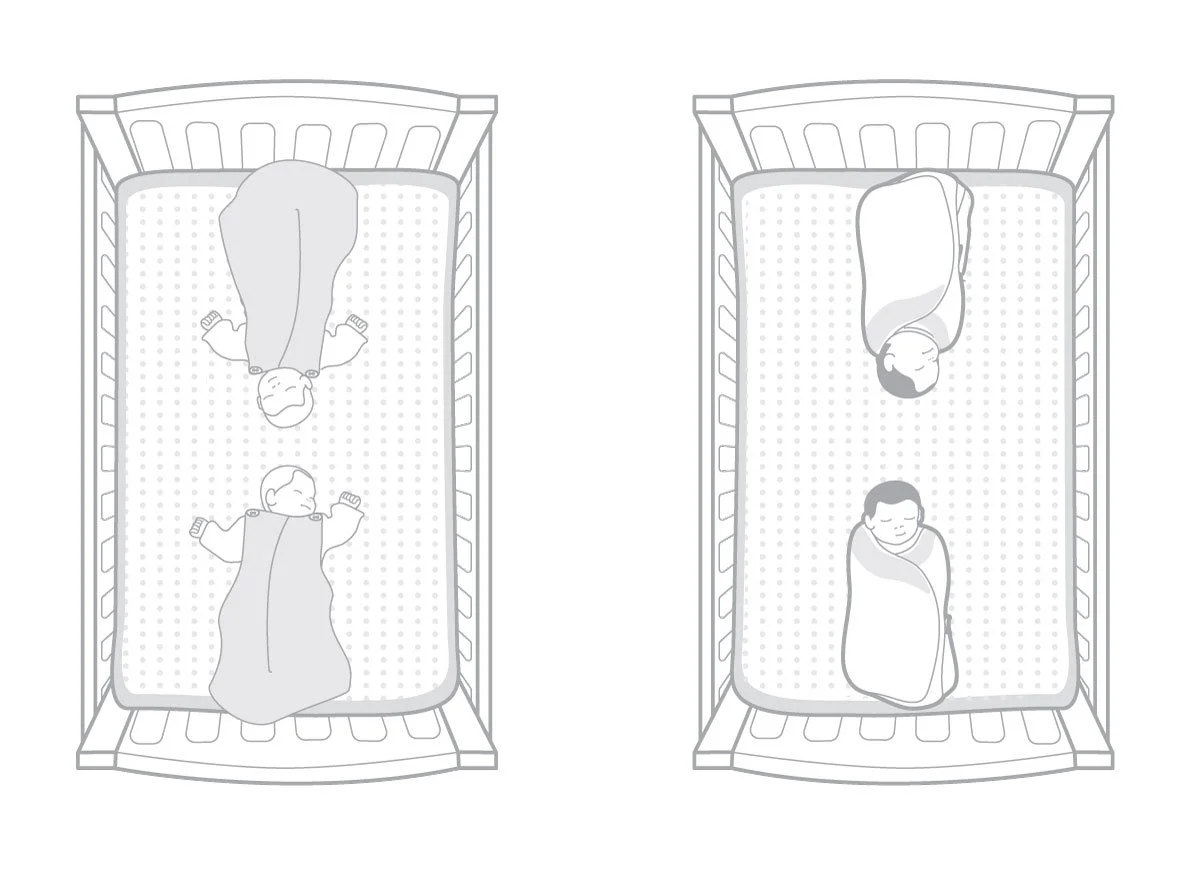Cosleeping with Twins and More
Cosleeping is an umbrella term encompassing the following practices:
Bed sharing
Room sharing
Using a “side-car” cosleeper
Cobedding is a term specific to babies who shared a womb sharing a sleep space.
Babies born at full term can bed-share providing other safety recommendations can be met. However, one guideline is that no other child is in the bed, meaning only one twin at a time would be considered safe practice.
Prematurity is considered a risk factor for bed-sharing. Twins are significantly more likely to be born prematurely and/or low birth weight, ruling them out for safe bed-sharing.
Room sharing is recommended for all babies in the first six - twelve months. This describes sleeping in a separate sleep space like a bassinet or cot in the room the parents are sleeping in.
Co-bedding
Recommendations for multiple infants are not always clear.
A study carried out in New Zealand, based on postal surveys, investigated the prevalence of co-bedding and SIDS-related child care practices in twins (Hutchinson et al 2010). The researchers stated that despite a lack of evidence of the risks or benefits of co-bedding this practice was very popular, especially among younger twins (52% of 109 twin pairs co-bedded at 6 weeks of age, 31% at 4 months, and 10% at 8 months of age). The authors neither advocate nor warn against the practice of co-bedding due to the lack of sufficient data, and conclude that more research is needed.
Co-bedding twins in hospital rooming in
The National Health Service in the UK states:
You can put your twins to sleep in a single cot while they're small enough. This is called co-bedding and is perfectly safe. In fact, putting twins in the same cot can help them regulate their body temperatures and sleep cycles, and can soothe them and their twin. If you put your twins in the same cot, follow the same safe sleeping advice as for a single baby. They should be placed on their backs with the tops of their heads facing one another and their feet at opposite ends of the cot, or side by side on their backs, with their feet at the foot of the cot.
Sleeping twins safely at home
In Australia, Rednose.org.au state:
Although surveys demonstrate that co-bedding twins at home is common (> 50%) current evidence shows that the safest way to sleep twins at home is to place them in their own cot and follow the Red Nose safe sleeping guidelines. These guidelines aim to reduce the risk of SUDI, including SIDS and fatal sleep accidents.
Co-bedding twins would be dangerous if one part of the body of one twin were able to accidentally cover the face of the other causing an interference with breathing. A small observational study of 10 twin pairs sleeping in various side by side and head to head configurations showed that twins sleeping side by side occasionally impinged on, although did not obstruct, the airway of the other twin.
If parents decide to sleep their babies together, another dilemma arises – which sleeping positions are safe and comfortable?
Studies carried out by Ball (2006) showed that in the first month most co-bedded infants slept side-by-side. By the third month there was more variability, and those still co-bedded were positioned side-by-side, head-to-head and feet-to-feet. No evidence was found that any of these arrangements is more or less safe, comfortable, or connected with sleep duration.
https://www.basisonline.org.uk/how-twins-co-bed/
Rednose.org.au recommend:
When it comes to the US, The American Academy of Pediatrics differs from countries like the United Kingdom and Australia - who recognise telling people not to bed-share doesn't stop the practice so all parents should be educated on reducing the risks. When it comes to co-bedding they are also conservative in their advice.
Based on the evidence, the AAP doesn't recommend bed sharing with your baby under any circumstances. This includes twins and other multiples.
The risk of multiples sleeping together outweighs any potential benefits and advises parents to have each baby sleep separately.
The problem with absolute advice is you then need to acknowledge people don’t always follow it, with additional advice:
Avoid falling asleep with your baby in other spots, too. The risk of sleep-related infant death is up to 67 times higher when infants sleep with someone on a couch, soft armchair or cushion.
Highest risk situation
What are tired parents of multiples to do?
Its pretty clear that the risks of SIDS are higher for premature and small babies. Non-breastfed babies are higher-risk than those ever breastfed. Babies in smoking households during and after pregnancy are also most vulnerable. Drugs and alcohol use increase risk
However, it is also recognised that intentional bed-sharing, with all adults aware of sharing a sleep space with their breastfed infant is a much safer prospect than accidental co-sleeping on a couch or sofa, arm chair or bean bag. Very tired parents sitting up to feed and settle babies risk falling asleep holding babies.
At the end of the day, it is recognised that most parents will bring their babies into bed with them at some stage and many will do so routinely as their babies get older. Educating families about risk minimisation, rather than risk eradication is important. Fear-based campaigns against bed-sharing simply lead adults to sit up holding babies: the only increase in infant death rates in recent years has been in babies experiencing fatal sleep accidents of













